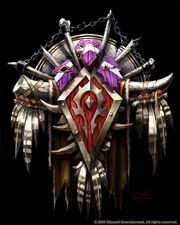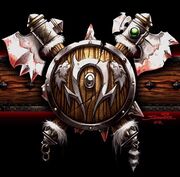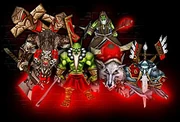![]() Alliance |
Alliance | ![]() Horde
Horde

Crest of the Horde
The Horde is one of the two major political factions of the mortal races in Azeroth, its counterpart being the Alliance.
Members[]
Major member races include:
- The orcs
- Led by Warchief Thrall.
- Capital is Orgrimmar in Durotar. They also have camps in the Barrens, Ashenvale, Stranglethorn Vale, Arathi Highlands, Badlands, Swamp of Sorrows and Azshara.
- Attempting to embrace their once honorable, shamanistic ways and control the corruption of demonic magic.
- For information on surviving orc clans that have joined Thrall, read about the New Horde.
- The island trolls of the Darkspear tribe
- Led by Shadowhunter Vol'jin.
- Share a capital with the orcs in Orgrimmar. They also have camps in Durotar, Ashenvale, Stonetalon Mountains and Desolace.
- Indebted to the orcs for saving their tribe and giving them a home.
- The tauren
- Led by Grand Chief Cairne Bloodhoof.
- Capital is Thunder Bluff in Mulgore. They also have camps in the Barrens, Thousand Needles, Stonetalon Mountains, Desolace and Feralas.
- A race of noble creatures who offered spiritual guidance to the orcs in exchange for their military aid.
- The undead
- Led by the Banshee Queen Sylvanas Windrunner, with Varimathras as her majordomo.
- Capital is the Undercity in Tirisfal Glades. They also have holdings in Silverpine Forest and the Hillsbrad Foothills.
- A group of undead released from the control of the Lich King who have set up a shaky truce with the other members of the Horde.
Other smaller powers are also part of the Horde:
- The Stonemaul ogres of Dustwallow Marsh, led by Mok'Morokk though many support Tharg instead.
- The forest trolls of the Revantusk tribe in the Hinterlands, led by Primal Torntusk.
- A few goblins controlling the zeppelins.
History[]

Crest of the Horde during the Second War

Notable figures from the Third War, from left to right: Cairne Bloodhoof, Samuro, Drek'Thar, and Rokhan. All of these Heroes also helped Rexxar in his journeys.
In the past, the Horde referred to the orcs and their battle thralls from both Draenor and Azeroth, such as trolls and ogres (see more about the old Horde). Following its utter defeat at the end of the Second War, the old Horde's power was forever broken, allowing Thrall to awaken the dormant spirituality of his people and free them from the Burning Legion's control.
During the events of the Third War, Thrall has made lasting bonds with the tauren chief Cairne Bloodhoof and the troll shadowhunter Vol'jin of the Darkspear clan. The ties between the three races is very close, as both share many similar cultural views. With the help of the tauren, both the orcs and the tribe of trolls have established a place for themselves in Kalimdor. Since then, certain ogre tribes, as well as the Forsaken (due to their lack of other options), have chosen to affiliate themselves with the Horde.
Organization[]
The Horde may be viewed as a more centralized body than the Alliance, as Orgimmar is the obvious center, with Thrall the undisputed leader. Like the old Alliance of Lordaeron, Thrall accepts ambassadors and advisors from all the different tribes and members of the Horde and makes sure their voice is heard in the running of the fledgling empire. Although unavoidably posessing the characteristic militarism of the orcs, Thrall has also proven himself to be a compassionate, idealistic, and enlightened individual, and commands a great deal of respect within the Horde. Though the Horde could quickly become a formidable war machine once again, they are a very peaceful nation deciding to try for peace and help the world rather than savage rampaging like the Old Horde.
The fact is that, though equal in size, the Horde is actually more complex than the Alliance. The main four races of the Tauren, Forsaken, Trolls and orcs have countless friends among the races of Azeroth: the Revantusk forest trolls of the Hinterlands, the Stonemaul Ogres and various individuals like the Mok'Nathal beastmaster Rexxar and the Pandaren Chen Stormstout.
In the Third War, and before the liberation of the Forsaken from the Scourge, the Horde allied themselves with the Alliance to rid Azeroth of the Burning Legion. Since then old animosity has risen again, resulting in open conflict on several battlefields.
Despite their somewhat monstrous appearance, the majority of the Horde is not evil; much like the Alliance, it is comprised of diverse factions and individuals who possess a wide range of values and virtues.
It should be noted that above all else, the members of the Horde value honor.
| |||||||||||||||||||||||||||||||
